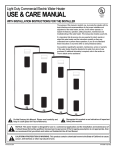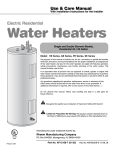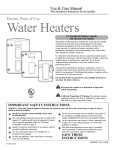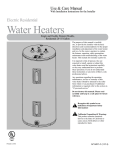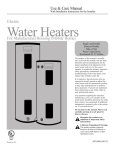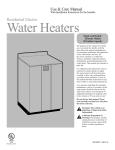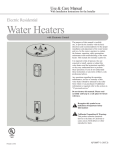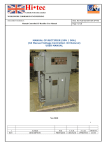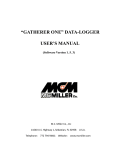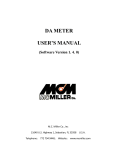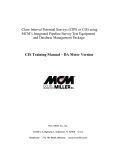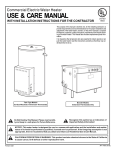Download Perfect Fit TEGSP20 480 Volt 3kw POU Use and Care Manual
Transcript
Commercial Point-of-Use Electric Water Heater USE & CARE MANUAL ® LISTED 786H WITH INSTALLATION INSTRUCTIONS FOR THE CONTRACTOR The purpose of this manual is twofold: one, for the installing contractor, to provide requirements and recommendations for the proper installation and adjustment of the water heater; and two, for the owner-operator, to explain the features, operation, safety precautions, maintenance and trouble shooting of the water heater. This manual also includes replacement parts information. It is imperative that all persons who are expected to install, operate or adjust this water heater read the instructions carefully so that they may understand how to do so. ! Do Not Destroy this Manual. Please read carefully and keep in a safe place for Future Reference. ! Recognize this symbol as an Indication of Important Safety Information! ! NOTICE: This water heater is designed for use in a commercial application and the installation and maintenance of it should be performed by qualified, licensed service personnel. If the foregoing assumption is not appropriate, then we recommend that you obtain and retain our Residential Use & Care Manual. ! CALIFORNIA PROPOSITION 65 WARNING: This product contains chemicals known to the State of California to cause cancer, birth defects or other reproductive harm. Printed in USA AP12129-4 (01/05) ! General Safety Precautions Be sure to read and understand the entire Use & Care Manual before attempting to install or operate this water heater. It may save you time and cost. Pay particular attention to the General Safety Precautions. Failure to follow these warnings could result in serious bodily injury or death. Should you have problems understanding the instructions in this manual, or have any questions, STOP, and get help from a qualified installer, service technician, or the local electric utility. shut off the elements. To find the hot water temperature being delivered, turn on a hot water faucet and place a thermometer in the hot water stream and read the thermometer. To meet commercial water use needs, the thermostat on this water heater is adjustable to deliver water up to 170°F. However, water temperatures over 125°F. can cause severe burns instantly or death from scalds. This is the preferred starting point for setting the control for supplying general purpose hot water. The following chart details the relationship of water temperature and time with regard to scald injury and may be used as a guide in determining the safest water temperature for your applications. TIME / TEMPERATURE RELATIONSHIPS IN SCALDS ! Temperature 120° F 125° F 130° F 135° F 140° F 145° F 150° F 155° F DANGER Time to Produce Serious Burn More than 5 minutes 11/2 to 2 minutes About 30 seconds About 10 seconds Less than 5 seconds Less than 3 seconds About 11/2 seconds About 1 second Table courtesy of Shriners Burn Institute The temperature of the water in the heater can be regulated by adjusting the thermostat. To comply with safety regulations the thermostat was set at the factory to a setting corresponding to 120°F. HOT R ESE T T R ESE Reset Button BURN Thermostat Dial Pointer Water temperature over 125°F can cause severe burns instantly or death from scalds. 110 170 120 160 150 140 130 TURN OFF POWER BEFORE SERVICING Children, disabled and elderly are at highest risk of being scalded. See instruction manual before setting temperature at water heater. Feel water before bathing or showering. Temperature limiting valves are available, see manual. Thermostat Protective Cover The illustration above shows the temperature adjustment dial used for setting the water temperature. Refer to Operation section of this manual for detailed instructions in how to adjust the thermostat(s). ! DANGER There is a Hot Water SCALD Potential if the thermostat is set too high. NOTE: When this water heater is supplying general purpose hot water requirements for use by individuals, a thermostatically controlled mixing valve for reducing point of use water temperature is recommended to reduce the risk of scald injury. Contact a licensed plumber or the local plumbing authority for further information. Safety and energy conservation are factors to be considered when setting the water temperature on the thermostat. The most energy efficient operation will result when the temperature setting is the lowest that satisfies the needs consistent with the application. Maximum water temperatures occur just after the thermostat has 2 Introduction The location chosen for the water heater must take into consideration the following: lower floors of the structure. Where such areas cannot be avoided, it is recommended that a suitable catch pan, adequately drained, be installed under the water heater. LOCAL INSTALLATION REGULATIONS This water heater must be installed in accordance with these instructions, local codes, utility company requirements or, in the absence of local codes, the latest edition of the National Electrical Code. It is available from some local libraries or can be purchased from the National Fire Prevention Association, Batterymarch Park, Quincy, MA 02269 as booklet ANSI/NFPA 70. NOTE: Auxiliary catch pan installation MUST conform to local codes. LOCATION This water heater is designed to meet a wide range of applications. It fulfills a demand for a small water heater that can be installed in a limited space such as under counter tops, in cabinets or in a closet. Locate the water heater in a clean dry area as near as practical to hot water fixtures, or close to the hot water faucet most frequently used. Place the water heater in such a manner that the thermostat and element access panels can be removed to permit inspection and servicing such as removal of elements or checking controls. The water heater and water lines should be protected from freezing temperatures. Do not install the water heater in outdoor, unprotected areas. B A — Diameter of water heater plus 2" min. A B — Maximum 2" To open drain, line should be at least 3/4" ID and pitched for proper drainage. Figure 1. — Auxiliary Catch Pan ! CAUTION Catch Pan Kits are available from the distributor or store where the water heater was purchased The water heater should not be located in an area where leakage of the tank or connections will result in damage to the area adjacent to it or to Installation 1. INSPECT SHIPMENT — Inspect the water heater for possible damage. Check the markings on the rating plate of the water heater to be certain the power supply corresponds to that for which the water heater is equipped. The suggested method of controlling thermal expansion is to install an expansion tank in the cold water line between the water heater and the check valve. The expansion tank is designed with an air cushion built in that compresses as the system pressure increases, thereby relieving the over pressure condition and eliminating the repeated operation of the relief valve. Other methods of controlling thermal expansion are also available. Contact your installing contractor, water supplier, or plumbing inspector for additional information regarding this subject. 2. THERMAL EXPANSION — Determine if a check valve exists in the inlet water line. It may have been installed in the cold water line as a separate back flow preventer, or it may be part of a pressure reducing valve, water meter or water softener. A check valve located in the cold water inlet line can cause what is referred to as a ”closed water system”. A cold water inlet line with no check valve or back flow prevention device is referred to as an ”open” water system. IMPORTANT!! Do not apply heat to the hot or cold water supply fitting. If sweat connections are used, sweat tubing to adapter before fitting adapter to cold water inlet of heater. Any heat applied to the hot or cold water supply fittings will permanently damage them. As water is heated, it expands in volume and creates an increase in the pressure within the water system. This action is referred to as ”thermal expansion”. In an ”open” water system, expanding water which exceeds the capacity of the water heater flows back into the city main where the pressure is easily dissipated. 3. WATER SUPPLY CONNECTIONS — Refer to Fig. 2 or 3 for suggested typical installation. The installation of unions or flexible copper connectors on the water connections is recommended so that the water heater may be easily disconnected for servicing if necessary. Connect cold water supply line to 3/4” pipe connection near the bottom of water heater. (Refer to Figure 2.) Install a shut-off valve and a drain valve (not supplied) in the cold water line near the water heater (Refer to Fig. 2.). Connect hot water line to 3/4” pipe connection marked HOT on the side near the top of the water heater. On the some models, the hot and cold water connections are 1/2” pipe connections and are located on top of the heater. (Refer to Figure 3.) A drain valve is supplied on these models. Local codes may require an Anti-Syphon device on the water inlet of a side connect water heater. A ”closed water system”, however, prevents the expanding water from flowing back into the main supply line, and the result of ”thermal expansion” can create a rapid, and dangerous pressure increase in the water heater and system piping. This rapid pressure increase can quickly reach the safety setting of the relief valve, causing it to operate during each heating cycle. Thermal expansion, and the resulting rapid, and repeated expansion and contraction of components in the water heater and piping system can cause premature failure of the relief valve, and possibly the heater itself.Replacing the relief valve will not correct the problem! 3 Installation Vacuum Relief Valve (Not Supplied) Union Recommended Heat Trap 6" Min. Unions Anode Hot Water Outlet to Fixtures Temperature Pressure Relief Valve If required, install per local codes and valve manufacturer’s instructions. Temperature & Pressure Relief Valve Shut-Off Valve Cold Water Supply To Cold Water Supply Relief Valve Discharge Line to suitable open drain Power Supply Cord 21/2 gal. models only Relief Valve Discharge Line Drain valve* Shut-Off Valve Hot Water Outlet (To Fixtures) Jacket Access Panel 6" Air Gap 6" Auxiliary Catch Pan Auxiliary Catch Pan Opening for 1/2" or 3/4" Electrical Fitting (Use only Copper Conductors) Drain Valve (Not Supplied) Auxiliary Catch Pan Drain Line Suitable Open Drain *Drain valve is located below and to right of Jacket Access Panel and is not visible in this view. Jacket Access Panel Figure 3. — Typical Under Counter Top Connect Installation Figure 2. — Typical Side Connect Installation 4. RELIEF VALVE — A new combination pressure and temperature relief valve, complying with the Standard for Relief Valves and Automatic Gas Shutoff Devices for Hot Water Supply Systems, ANSI Z21.22, must be installed in the opening provided and marked for the purpose on the water heater. (Refer to Fig. 2 or 3.) No valve of any type should be installed between the relief valve and the tank. Local codes shall govern the installation of relief valves. ! WARNING Tank MUST BE full of water before power is turned on. Heating element(s) WlLL BE DAMAGED if energized for even a short time while tank is dry. The water heater’s warranty does not cover damage or failure resulting from operation with an empty or partially empty tank. (Reference is made to the limited warranty for complete terms and conditions.) The pressure rating of the relief valve must not exceed 150 psi, the maximum working pressure of the water heater as marked on the rating plate. The BTUH Rating of the relief valve must not be less than the input rating of the water heater as indicated on the rating label located on the front of the heater (1 watt = 3.412 BTUH). 6. ELECTRICAL CONNECTIONS — The voltage requirements and wattage load for all heaters is specified on the rating plate. Table 1 recommends minimum branch circuit sizing based on the National Electrical Code. All wiring must conform to local codes or latest edition of National Electrical Code ANSI/NFPA 70. Connect the outlet of the relief valve to a suitable open drain so that the discharge water cannot contact live electrical parts and to eliminate potential water damage. Piping used should be of a type approved for hot water distribution. The discharge line must be no smaller than the outlet of the valve and must pitch downward from the valve to allow complete drainage (by gravity) of the relief valve and discharge line. The end of the discharge line should not be threaded or concealed and should be protected from freezing. No valve of any type, restriction or reducer coupling should be installed in the discharge line. Some models are supplied with a plug connected power supply cord for use only in 120 VAC applications. The cord must be connected to a properly Total Water Heater Wattage 1440 1500 2000 2500 3000 4500 6000 5. TO FILL WATER HEATER — Make certain drain valve is completely closed. Open shut-off valve in cold water supply line. Open each hot water faucet slowly to allow air to vent from the water heater and piping. A steady flow of water from the hot water faucet(s) indicates a full water heater. Table 1. — 4 Recommended Over Current Protection (Fuse or Circuit Breaker) Amperage Rating Copper Wire Size AWG Based on N.E.C. Table 310-16 (75°C.) 120V 208V 240V 277V 480V 120V 208V 240V 277V 480V 15 --------14 --------20 15 15 15 15 12 14 14 14 14 25 15 15 15 15 10 14 14 14 14 30 15 15 15 15 10 14 14 14 14 35 20 20 15 15 8 12 12 14 14 --30 25 25 15 --10 10 10 14 --40 35 30 20 --8 8 10 12 Branch Circuit Sizing and Wire Size Guide Based on N.E.C. ANSI / NFPA 70 Installation grounded receptacle on a branch circuit with copper conductors, an over current protection device and a suitable disconnect means. If desired, straight field wiring connections can be made to these models by removing the access cover on front of the heater and disconnecting the cord set from the thermostat and the grounding lug. Remove the cord set and strain relief bushing from the junction bracket. The hole in the junction bracket will accommodate 1/2” or 3/4” electrical fittings. Refer to wiring diagrams on back cover of this manual for wiring connections. separate conductor for grounding. It should be attached to the ground terminals of the water heater and the electrical distribution box. ! WARNING The manufacturer’s warranty does not cover any damage or defect caused by installation, attachment or use of any type of energy saving or other unapproved devices (other than those authorized by the manufacturer) into, onto or in conjunction with the water heater. The use of unauthorized energy saving devices may shorten the life of the water heater and may endanger life and property. The manufacturer disclaims any responsibility for such loss or injury resulting from the use of such unauthorized devices. Some models are completely wired to the junction bracket inside the jacket at the front of the water heater. An opening for 1/2” or 3/4” electrical fitting is provided for field wiring connections. A separate branch circuit with copper conductors, overcurrent protective device and suitable disconnecting means must be provided by a qualified electrician. Refer to wiring diagrams on back cover of this manual for wiring connections. If local codes require external application of insulation blanket kits the manufacturer’s instructions included with the kit must be carefully followed. ! CAUTION ! CAUTION The presence of water in the piping and water heater does not provide sufficient conduction for a ground. Non-metallic piping, dielectric unions, flexible connectors etc. can cause the water heater to be electrically isolated. The branch circuit wiring should include either: Application of any external insulation to this water heater will require careful attention to the following: • Do not cover the temperature and pressure relief valve. • Do not cover jacket access panels to thermostats and heating elements. A. Metallic conduit or metallic sheathed cable approved for use as a grounding conductor and installed with fittings approved for the purpose. B. Non-metallic sheathed cable or metallic conduit or metallic sheathed cable not approved for use as a ground conductor shall include a • Do not cover electrical junction box of water heater. • Do not cover operating or warning labels attached to the water heater nor attempt to relocate them on exterior of insulation blanket. Installation Check List ❑ Water connections tight and free of leaks A. Water Heater Location C. Relief Valve ❑ Close to area of heated water demand. ❑ Temperature and Pressure Relief Valve properly installed ❑ Indoors and protected from freezing temperatures. and discharge line run to open drain ❑ Area free of flammable vapors. ❑ Discharge line protected from freezing. ❑ Provisions made to protect area from water damage. D. Wiring ❑ Sufficient room to service water heater. ❑ Power supply voltage agrees with water heater rating plate. B. Water Supply ❑ Branch circuit wire and fusing or circuit breaker of proper size. ❑ Water heater completely filled with water. ❑ Electrical connections tight and unit properly grounded. ❑ Water heater and piping air vented. Model No. Serial No. Date of Installation 5 Installed By: Operation SAFETY PRECAUTIONS A. Do turn off power to water heater if it has been subjected to over heating, fire, flood or physical damage. ! CAUTION Hydrogen gas can be produced in a hot water system served by this water heater that has not been used for a long period of time (generally two weeks or more). HYDROGEN GAS IS EXTREMELY FLAMMABLE!! To dissipate such gas and to reduce risk of injury, it is recommended that the hot water faucet be opened for several minutes at the kitchen sink before using any electrical appliance connected to the hot water system. If hydrogen is present, there will probably be an unusual sound such as air escaping through the pipe as the water begins to flow. Do not smoke or use an open flame near the faucet at the time it is open. B. Do Not turn on water heater unless it is filled with water. C. Do Not turn on water heater if cold water supply shut-off valve is closed. D. If there is any difficulty in understanding or following the OPERATION or MAINTENANCE instructions, it is recommended that a qualified person or serviceman perform the work. 1. WATER TEMPERATURE SETTING — The temperature of the water in the water heater can be regulated by setting the temperature dial of the adjustable surface mounted thermostat located behind the jacket access panel. To comply with safety regulations the thermostat is factory set at 120° F or less where local codes require. Temperature 120° F 125° F 130° F 135° F 140° F 145° F 150° F 155° F R ESE ESE T T Reset Button TIME / TEMPERATURE RELATIONSHIPS IN SCALDS R Thermostat Dial Pointer Time to Produce Serious Burn More than 5 minutes 11/2 to 2 minutes About 30 seconds About 10 seconds Less than 5 seconds Less than 3 seconds About 11/2 seconds About 1 second Table courtesy of Shriners Burn Institute 110 170 120 160 150 140 ! DANGER 130 TURN OFF POWER BEFORE SERVICING Make certain power to water heater is OFF before removing jacket access panel FOR ANY REASON. If adjustment is necessary, turn off power to water heater, remove jacket access panel and insulation exposing thermostat. The thermostat protective cover should not be removed. Set thermostat dial pointer, with a small screwdriver, to desired temperature. (Refer to Fig. 4.) Replace insulation and jacket access panel. Turn on power to water heater. Thermostat Protective Cover CAUTION!! — Hotter water increases the risk of SCALDING! This illustration shows the temperature adjustment dial used for setting the water temperature. Refer to Section 1 - Water Temperature Setting, above, for more details and safety instructions regarding water temperature setting. 2. SAFETY CONTROLS — The water heater is equipped with a combination Thermostat and Temperature Limiting Control (ECO) that is located above the heating element in contact with the tank surface. If for any reason the water temperature becomes excessively high, the Temperature Limiting Control (ECO) breaks the power circuit to the heating element. Once the control opens, it must be reset manually. Figure 4. — Thermostat and Protective Cover. Safety and energy conservation are factors to be considered when selecting the water temperature setting of the water heater’s thermostat. The lower the temperature setting the greater the savings in energy and operating costs. ! DANGER ! CAUTION The cause of the High Temperature Condition must be investigated by qualified service personnel and corrective action taken before placing the water heater in service again. There is a Hot Water SCALD Potential if the thermostat is set too high. NOTE: When this water heater is supplying general purpose hot water requirements for use by individuals, a thermostatically controlled mixing valve for reducing point of use water temperature is recommended to reduce the risk of scald injury. Contact a licensed plumber or the local plumbing authority for further information. To reset Temperature Limiting Control, turn off power to water heater, remove jacket access panel and insulation. The thermostat protective 6 Operation cover SHOULD NOT be removed. (Refer to Fig. 4.) Press red “RESET” button. Replace insulation and jacket access panel before turning on power to water heater. In order to drain water heater, turn off cold water supply, then it is necessary to open a hot water faucet or lift the handle on the relief valve to admit air to the tank. Attach a garden hose to the drain valve on the water heater and direct the stream of water to a drain where it will do no damage. 3. EMERGENCY INSTRUCTIONS — ! WARNING ! DANGER If water heater has been subjected to flood,fire,or physical damage, turn off power and water to water heater. Do not operate the water heater again until it has been thoroughly checked by qualified service personnel. The water drained from the tank may be hot enough to present a SCALD HAZARD and should be directed to a suitable drain to prevent injury or damage. 4. LONG TIME SHUT-DOWN — If the water heater is to remain idle for an extended period of time, the power and water to the water heater should be turned off to conserve energy. The water heater and piping should be drained if they might be subjected to freezing temperatures. 6. ANODE — This water heater is equipped with an anode rod designed to prolong the life of the glass lined tank. The anode is slowly consumed cathodically, thereby eliminating or minimizing corrosion of the glass lined tank. NOTE: Refer to “Hydrogen Gas Caution” in Safety Precautions Section on page 6. Water sometimes contains a high sulfate and/or mineral content and together with the cathodic protection process can produce a hydrogen sulfide or rotten egg odor in the heated water. Chlorination of the water supply should minimize the problem. After a very long shut-down period, the water heater’s operation and controls should be checked by qualified service personnel. Make certain the water heater is completely filled before again placing it in operation . NOTE: Do not remove the anode rod from the water heater’s tank, except for inspection and/or replacement, as operation with the anode rod removed will shorten the life of the glass lined tank and will exclude warranty coverage. 5. DRAINING HEATER — ! CAUTION Shut off power to water heater before draining water. Maintenance Properly maintained, your water heater will provide years of dependable trouble-free service. It is suggested that a routine preventive maintenance program be established and followed by the user. It is further recommended that a periodic inspection of the operating controls, heating element and wiring should be made by service personnel qualified in electric appliance repair. NOTE: If the temperature and pressure relief valve on the water heater discharges periodically, this may be due to thermal expansion in a “Closed” water system. Contact the water supplier or your plumbing contractor on how to correct this. DO NOT plug the relief valve outlet. D. A water heater’s tank can act as a settling basin for solids suspended in the water. It is, therefore, not uncommon for hard water deposits to accumulate in the bottom of the tank. It is suggested that a few quarts of water be drained from the water heater’s tank through the drain valve every month to clean the tank of these deposits. 1. ROUTINE PREVENTATIVE MAINTENANCE A. Most electrical appliances make some sound when in operation, even when new. If the hissing or singing sound level increases excessively, the electric heating element may require cleaning. Contact your installer or plumbing contractor to inspect. E. Rapid closing of faucets or solenoid valves in automatic water using appliances can cause a pounding “water hammer” sound. “Water hammer” can be described as a banging noise heard in a water pipe following an abrupt alteration of the flow with resulting pressure surges. Strategically located risers in the water pipe system can be used to minimize the problem. Also water hammer arresting devices are usually available from your plumber or local plumbing supply store. B. The area near the water heater must be kept free of flammable liquids such as gasoline or paint thinners, adhesives or other combustible materials. C. At least once a year, lift and release the lever handle on the temperature pressure relief valve, located near the top of the water heater, to make certain the valve operates freely and allow several gallons to flush through discharge line. Make certain the discharged water is directed to an open drain. 2. ANODE ROD INSPECTION — The anode rod should be removed from the water heater’s tank annually for inspection and replaced when more than 6” of core wire is exposed at either end of the rod. Refer to Fig. 2 for anode rod location. Make certain cold water supply is turned off before removing anode rod. ! DANGER Before manually operating the relief valve, make certain no one will be exposed to the danger of coming in contact with the hot water released by this valve. The water may be hot enough to create a SCALD hazard. The water released should be directed to a suitable drain to prevent injury or damage. 7 Replacement Parts List Instructions for placing a Parts Orders: Address parts orders to the distributor or store from where the heater was purchased. All parts orders should include: 1. Model number and Serial number of heater (from rating plate). 2. Specify voltage and wattage as marked on rating plate. 3. Part Description (as noted below) and number of parts desired. Top Connect Models 120 or 240 Volt Operation 6 4 7 5 T ES E ER R SE T 09 001 CS ID- 041 031 011 O - M 021 RE HT 10 FFO RE NRU E WO T GNROFEP ICI B VR ES 9 3 1 2 8 Ref. No. Part Description Qty. Req’d 1. 2. 3. 4. 5. 6. 7. 8. 9. 10. Heating Element Heating Element Gasket Thermostat Bracket Thermostat Thermostat Protective Cover Cavity Insulation Jacket Access Panel Drain Valve Drain Valve Shroud Electrical Cord Set (120 VAC models ONLY) 1 1 1 1 1 1 1 1 1 1 ! CAUTION For your safety, DO NOT attempt repair of electrical wiring, thermostats, heating elements or other operating controls. Refer repairs to qualified service personnel. 8 Replacement Parts List Instructions for placing a Parts Orders: Address parts orders to the distributor or store from where the heater was purchased. All parts orders should include: 1. Model number and Serial number of heater (from rating plate). 2. Specify voltage and wattage as marked on rating plate. 3. Part Description (as noted below) and number of parts desired. Side Connect Models 120, 208, 240, 277 or 480 Volt Operation 11 12 10 8 R 4 E 5 6 7 SE T RE SE T 90 140 130 100 110 - D I S C 120 O MER TH N OFF TUR ER POW ORE NG BEF VICI SER 10 2 9 1 3 Ref. No. 1. 2. 3. 4. 5. 6. 7. 8. 9. 10. 11. 12. Part Description Heating Element Heating Element Gasket Thermostat Bracket Thermostat Thermostat Protective Cover Cavity Insulation Jacket Access Panel Nipple, Hot Outlet/J-Tube (Not Shown) Nipple, Cold Inlet Shroud Anode Rod Snap Bushing Qty. Req’d 1 1 1 1 1 1 1 1 1 As Req’d 1 1 ! CAUTION For your safety, DO NOT attempt repair of electrical wiring, thermostats, heating elements or other operating controls. Refer repairs to qualified service personnel. 9 Trouble Shooting Guide NATURE OF TROUBLE No Hot Water POSSIBLE CAUSE SERVICE 1. Manual switch turned off 2. Improper Wiring 3. No Power — blown fuse or circuit breaker tripped a. Shorted wiring b. Circuit overloaded c. Improper wiring d. Grounded element or thermostat 4. Manual Reset Limit (ECO) open a. Thermostat(s) defective b. Thermostat out of calibration c. Heat build-up due to loose wires d. Defective Limit (ECO) Turn to ON ** Rewire per Wiring Diagram ** ** ** ** ** ** ** ** Replace or repair Provide adequate circuit or reduce load Rewire per diagram Replace Refer to "Operation Section" Replace Lower setting or replace Tighten wire connections Replace Not enough Hot Water 1. Heater undersized 2. Defective Element(s) 3. Miswired or defective thermostat causing only one element to work Reduce rate of hot water use ** Check amperage, replace element if low ** Check wiring or replace Water too hot or not hot enough 1. Thermostat setting too high or low 2. Thermostat out of calibration Change setting as required ** Replace Noisy heating element(s) 1. Scale build-up on elements ** Remove and clean ! CAUTION ** For your safety, DO NOT attempt repair of Electrical Wiring, Thermostat(s), Heating Elements or other Operating Controls. Refer repairs to qualified service personnel. How to Obtain Service Assistance 1. Should you have any questions about your new water heater, or if it requires adjustment, repair, or routine maintenance, it is suggested that you first contact your installer, plumbing contractor or previously agreed upon service agency. In the event that the firm has moved, or is unavailable, refer to the telephone directory commercial listings or local utility for qualified service assistance. 2. Should your problem not be solved to your complete satisfaction, you should then contact the Manufacturer’s National Service Department at the following address: 2600 Gunter Park Drive Montgomery, Alabama 36109-1413 Phone: 1-800-432-8373. 10 When contacting the manufacturer, the following information should be made available: a. Model and serial numbers of the water heater as shown on the rating plate attached to the jacket of the heater. b. Address where water heater is located and can be seen. c. Name and address of installer and any service agency who performed service on the water heater. d. Date of original installation and dates any service work was performed. e. Details of the problem as you can best describe them. f. List of people, with dates, who have been contacted regarding your problem. THIS PAGE WAS INTENTIONALLY LEFT BLANK. 11 Wiring Diagrams Therm-O-Disc Thermostats (Type 59T) WHITE 2 4 BLACK HEATING ELEMENT JUNCTION BOX THERMOSTAT & HIGH TEMP. LIMIT (ECO) 2 1 2 BLACK 1 1 2 120 V Plug Connected Cord Set ONLY 2 HEATING ELEMENT N BLACK THERMOSTAT & HIGH TEMP. LIMIT (ECO) BLACK 1 3 RED 2 1 G* WHITE THERMOSTAT & HIGH TEMP. LIMIT (ECO) H L BLACK BLACK 1 G JUNCTION BOX L RED N DISTRIBUTION PANEL JUNCTION BOX G* H TO PROPERLY GROUNDED RECEPTACLE ON BRANCH CIRCUIT TO ELECTRICAL DISTRIBUTION PANEL BRANCH CIRCUIT TO ELECTRICAL BRANCH CIRCUIT TO ELECTRICAL DISTRIBUTION PANEL HEATING ELEMENT 120 V ONLY SINGLE ELEMENT FIG. A SINGLE ELEMENT FIG. B SINGLE ELEMENT FIG. C THIS ELECTRIC WATER HEATER IS WIRED AS INDICATED ABOVE 12












